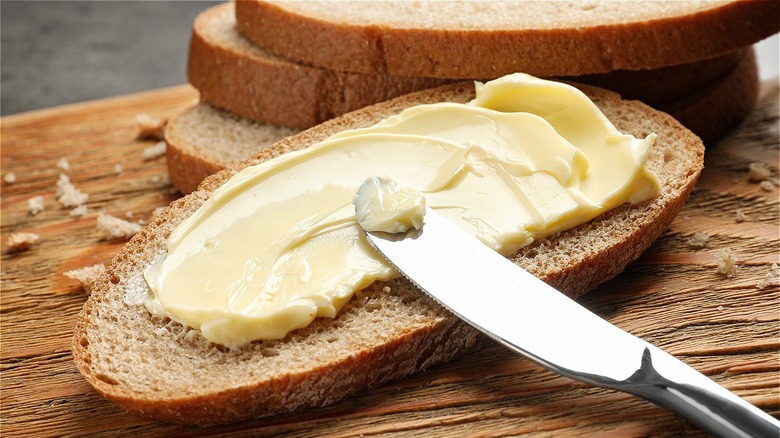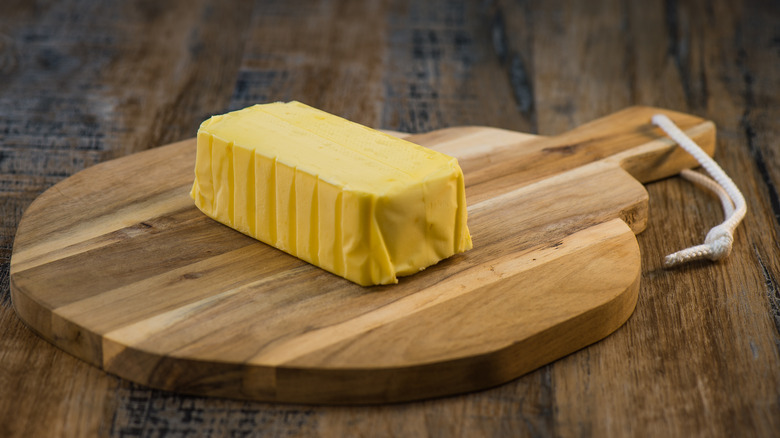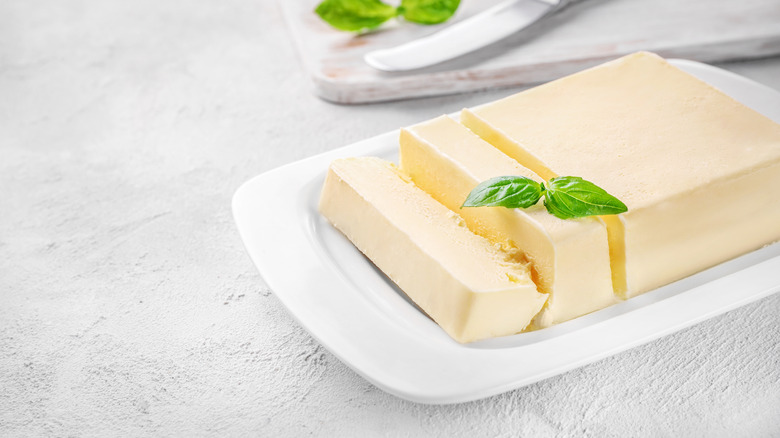What Is Grass-Fed Butter And Is It More Nutritious Than Regular Butter?
Grass-fed butter, along with grass-fed beef and other products that fall within the "grass fed" nomenclature, have experienced a surge of trendiness in recent years. Sales of grass-fed meat have grown among consumers who value "taste and health, as well as animal welfare," when shopping for beef products (via Glanbia Nutritionists), and are projected to contribute to a global grass-fed beef market of $13.36 billion by 2025, per Research and Markets. Many of the shoppers opting for grass-fed beef may also choose to buy grass-fed butter. Other customers, however, may still be wondering: What actually constitutes as a "grass-fed" product? And — the big question — are they actually more healthful than non- grass-fed products?
Per Foodsmiths, butter has "been around for thousands of years, dating back to the domestication of cattle," and — grass-fed or not — it contains myriad nutrients, vitamins, and benefits for health. "A fat made by churning the cream of milk, most often from cows," explains The Spruce Eats, butter is a staple ingredient in homes around the world. But what about its lesser known relative, grass-fed butter?
What is grass-fed butter?
So, what exactly is grass-fed butter? As Kitchn notes, it's "produced from milk derived from cows that graze in grasslands rather than being fed a grain-based diet." This oftentimes means that grass-fed butter has a "richer yellow hue...and flavor than regular butter." According to the USDA, the only ingredients are pasteurized cream and salt.
Cooking Light (via CNN) interestingly states that "all cows do graze on pasture for the first six months to a year of their lives." Once they grow, however, they're often transferred to a grain-heavy diet, sometimes containing corn. USDA standards dictate that properly grass-fed cows, on the other hand, eat a diet "derived solely from forage" in the form of grass, forbs, "or cereal grain crops in the vegetative (pre-grain) state," which does not include grain or grain byproducts. Additionally, the animals should have "continuous access" to the pasture. Butter that meets these standards should be affixed with the grass-fed label, though A Greener World points out that the meaning behind these labels can vary based on which organization certifies them.
What are the differences between regular butter and grass-fed?
Just as you have to decide between cultured vs. sweet cream, organic vs. conventional, and salted vs. unsalted butter at the supermarket, your decision-making is further delayed by another question: grass-fed or not? Per Everyday Health, there are indeed clear flavor differences between the two. Registered Dietician Malina Linkas Malkani told the outlet that "while the flavor of grass-fed butter will change depending on the location and time of year that the cows grazed, the taste is generally richer and more intensely butter-flavored than regular butter."
Though grass-fed butter may taste more "buttery" than regular butter, depending on who you ask, it's virtually interchangeable with the conventional stuff when used for cooking and baking. If you're deciding between the two for your next culinary project, just consider how important it is to the recipe. If you're slathering it on a piece of freshly baked bread or making brown butter cookies, for example, it might be worth paying the extra money for grass-fed, since you'll really be able to taste it.
Nutritional information about grass-fed butter vs. regular
Grass-fed butter is said to have anti-inflammatory properties, as well as qualities that can bolster gut health, combat numerous diseases, and much more. Foodsmiths states that grass-fed butter is higher than standard butter in butyric acid, vitamin A, and conjugated linoleic acid (CLA), thanks to the extra nutrients the cows absorb from the grass. In fact, says Healthline, grass-fed butter may contain as much as five times more CLA than regular butter — significant for CLA's cancer-fighting properties in certain studies.
Kitchn also notes that organic grass-fed butter is high in other vitamins, such as D, E, and K2, as well as beta carotenes. Due to its nutritional profile, butter may help reduce consumers' likelihood of developing osteoporosis and heart disease — and it may even act as a weight-loss supplement, interestingly enough. Finally, per Taste Of Home, grass-fed butter is chockfull of "healthy fats and fat-soluble vitamins, more omega-3 fatty acids and fewer toxins" than regular butter, and it may also be a healthier option "than butter from grain-fed cows, whose diet may include hormones and antibiotics."
For many shoppers, grass-fed butter is a worthy splurge over its regular counterpart, whether for reasons of flavor, nutrition, or animal welfare. When choosing it (or any butter product), be sure to carefully read labels and certifications to understand how it was produced. As far as grass-fed butter vs. margarine — that's a conversation for another day!



